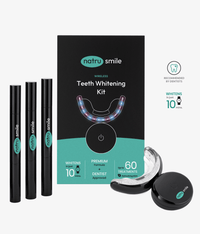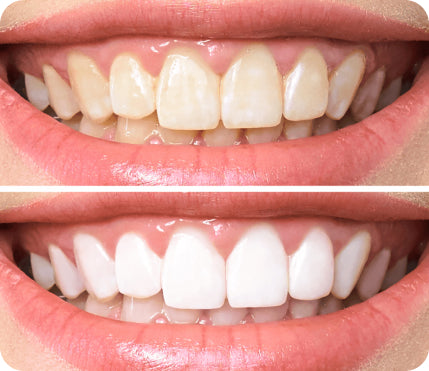
All products are certified by dental expert Dr. Greg Grillo
A bright and healthy smile can do wonders for your confidence and overall appearance. But with dozens of cosmetic dentistry options available today, it can be difficult to decide which procedure is right for you.
Two of the most popular choices to improve your smile are teeth bonding and veneers. Unlike natural teeth whitening or at-home teeth whitening solutions, bonding and veneers both last much longer – and can do a better job.
In this comprehensive comparison, we'll discuss the significant differences between teeth bonding vs veneers by examining factors such as procedure types, dental bonding costs, pros and cons, and longevity. Our goal is to provide you with enough information to help you make an informed decision about which treatment option best suits your individual needs and preferences, so you have other options to whiten your smile than just a teeth whitening kit.
Teeth Bonding: Overview, Pros, And Cons
Teeth bonding, also known as dental bonding or composite bonding, is a cosmetic dentistry technique that involves applying a tooth-colored resin directly to the tooth's surface. This resin is then sculpted, shaped, and polished to achieve the desired esthetic results. Typically used to repair chipped, discolored, or misshapen teeth, bonding is a relatively quick and straightforward procedure that usually requires no anesthesia or minimal tooth preparation.
Pros
- Less expensive compared to veneers
- Can be completed in a single dental visit
- Minimal tooth preparation is required
- The reversible procedure as it doesn't involve permanent tooth reduction
Cons
- Not as durable or stain-resistant as porcelain veneers
- May not look as organic as teeth whitening vs veneers
- Boasts a shorter lifespan, usually lasting up to 10 years (with proper care)
Veneers: Overview, Pros, And Cons
Overview
Veneers, also referred to as porcelain veneers or dental laminates, are thin shells of dental porcelain that are custom-made to fit over the front surface of a tooth. They improve the appearance of the tooth by covering imperfections like discoloration, chips, or misalignment.
The process of applying veneers typically requires removing a small amount of tooth enamel, followed by placing the veneer on the tooth with a strong bonding agent to provide a lasting connection. There are several types of veneers, including gum veneers for receding smiles (which usually involve painting a small portion of the top of the veneer to match your gums), and snap-on veneers (which are temporary and can easily be removed by the wearer).
Pros
- Highly durable and stain-resistant material
- Offer a more natural, esthetically pleasing look
- Long-lasting, often lasting up to 15-20 years
Cons
- More expensive than teeth bonding
- Irreversible process since a portion of the tooth enamel is removed
- May require multiple visits to complete the treatment
With the provided information, you should now have a deeper understanding of the differences between teeth bonding and veneers. While both teeth whitening options (assuming that’s what you’re doing it for) have their respective pros and cons, the ideal choice depends on your specific dental needs, budget, and desired outcome. Consult with your dentist to determine the most suitable cosmetic dentistry option for you.
Teeth Bonding Vs Veneers: A Comprehensive Comparison
Before diving deep into the subject, let's examine the key differences between veneers and teeth bonding in order to better understand both cosmetic dental procedures:
- Dental bonding, or composite bonding, is a technique where a tooth-colored resin material is applied directly onto the tooth's surface and then sculpted to achieve the desired result. This approach is perfect for addressing minor cosmetic issues, such as small gaps between teeth, minor chips, or slight discolorations. The process is relatively simple, less invasive, and often more affordable than veneers.
- Veneers, conversely, are wafer-thin shells made of porcelain or composite resin that are designed specifically to fit over a tooth's visible surface. These custom-made shells are appropriate for individuals seeking a solution for more significant aesthetic concerns, including the color and shading of teeth, as well as their size and shape. This procedure usually involves removing a minimal amount of tooth enamel to accommodate the veneer and picking a veneer color similar to that of your natural smile.
With a foundational understanding of bonded teeth and veneers, let's delve deeper into the unique characteristics, advantages, and disadvantages of each treatment option.
Dental Bonding
Advantages
- Affordability: Dental bonding is typically less expensive than veneers, making it a cost-effective option for minor cosmetic dental concerns.
- Less Invasive: There is minimal to no removal of tooth enamel during the bonding process, making it a more conservative treatment option.
- Repairability: If the bonded material chips or breaks, it is usually easier to repair compared to veneers as it can simply be reapplied and sculpted.
Disadvantages
- Staining: Bonded material may be more prone to staining than veneers and may require more maintenance in terms of polishing and touch-ups.
- Durability: The resin used in dental bonding may be less durable than the materials used in veneers, which may result in a need for more frequent replacements.
Veneers
Advantages
- Aesthetic Results: Veneers provide a uniform, natural-looking appearance that can address more extensive cosmetic concerns.
- Stain Resistance: Porcelain veneers are highly resistant to staining, maintaining their aesthetic appeal over time.
- Longevity: Veneers typically have a longer lifespan than dental bonding, with proper oral hygiene and care, they can last over a decade.
Disadvantages
- Cost: Veneers are generally more expensive than bonding, due to the custom fabrication and higher-quality materials used.
- Irreversible: In most cases, removal of a minimal amount of tooth enamel is necessary for veneer placement, which means this type of treatment is irreversible.
In conclusion, the choice between bonded teeth and veneers largely depends on the nature and extent of your cosmetic dental issues as well as your personal preferences and budget. It's important to have an in-depth discussion with your dentist to determine the most suitable treatment for your individual needs.
Teeth Bonding Vs Veneers: An In-Depth Comparison Of The Procedure, Time, & Aftercare
When comparing dental bonding and veneers, it's essential to examine several factors to determine which option is best suited to your needs. In this section, we'll delve into the procedure, time, and cost of both treatment methods to help you make an informed decision.
Procedure
- Teeth Bonding: Dental bonding is a relatively simple and quick procedure that requires minimal invasion. The dentist will etch the tooth surface, apply a bonding agent, and then place and shape the composite resin material. The resin is then hardened using ultraviolet (UV) light. Notably, dental bonding does not require any tooth reduction, so the process leaves the tooth intact, maintaining its structural integrity.
- Veneers: Contrasting with dental bonding, veneers require a more complex and invasive procedure. First, the dentist will remove a tiny layer of the tooth's enamel, which is necessary to make room for the veneer. Then, an impression of the prepared teeth is sent to a dental laboratory, where the veneers are fabricated. Finally, the veneers are cemented in place, and the dentist will make any necessary adjustments to ensure a proper fit.
Time
- Teeth Bonding: The process for dental bonding typically takes about 30 minutes to an hour per tooth, and it is usually completed in a single appointment. This makes dental bonding one of the fastest options and thus an attractive option for those who have tight schedules and require quick results.
- Veneers: Veneers may require two to three visits to complete the procedure, making them a more time-consuming option. The additional dental appointments are needed for tooth preparation, impression taking, the actual fitting of veneers, and the process of whitening composite veneers (if needed). Those who opt for veneers should keep in mind the extra time investment while deciding on this treatment.
Cost
- Teeth Bonding: Dental bonding is generally more affordable than veneers, primarily due to the simplicity of the procedure and the lower material expenses. The cost of dental bonding vs veneers can vary widely, depending on factors such as the dentist's fees, location, and materials used. As a general guide, expect dental bonding to cost around $200–$600 per tooth.
- Veneers: Veneers typically come with a heftier price tag, ranging from $500–$2,000 per tooth. The higher cost can be attributed to the intricacy of the process, the materials involved, and the added time necessary for lab work and multi-stage appointments. It's crucial to consider these factors if you're leaning toward choosing veneers.
In conclusion, when comparing dental bonding and veneers, it's crucial to assess the pros and cons of each treatment, taking into consideration the procedure, time, and cost involved. By doing so, you'll be better equipped to select the treatment that best suits your specific dental needs and preferences.
Aftercare For Dental Bonding And Veneers
When it comes to dental bonding and veneers, maintaining proper oral hygiene is of utmost importance. This includes not only the basics like flossing and brushing your teeth regularly but also scheduling regular dental checkups to ensure your bonded or veneered teeth remain in optimal condition. You must also listen to your dentist's advice and follow any specific care instructions they provide.
If you find yourself unsure about which option suits you best, consider examining bonding vs veneers pictures as a reference to get a better idea of the final results each treatment offers. This visual aid can be helpful in making an informed decision.
Situations Favoring Dental Bonding Over Veneers
The choice between dental bonding and veneers largely depends on your unique dental needs and the specific issues you wish to address. In some cases, dental bonding might be the more appropriate choice. Here’s a quick guide to dental bonding-preferred situations:
Enhancing The Appearance Of Discolored Teeth
Dental bonding can effectively improve the appearance and color of teeth that are mildly discolored, whether it's due to staining, aging, or other factors. This treatment can help rejuvenate your smile with a brighter, more even look.
Closing Small Gaps between Teeth
For individuals with minor gaps or spaces between their teeth, dental bonding can serve as an efficient and cost-effective solution. The bonding material seamlessly fills the gaps, resulting in a more uniform and visually appealing smile.
Repairing Chipped, Cracked, Or Decayed Teeth
If you have a minor chip, crack, or decayed area on your tooth, dental bonding can be an excellent choice for making these repairs. The versatile material used in dental bonding can effectively restore the appearance and function of your affected tooth.
Improving Tooth Shape Or Length
Dental bonding can also prove advantageous for those seeking to correct uneven or oddly shaped teeth or to make minor adjustments to tooth length. The bonding material can be applied and sculpted to achieve a more harmonious and aesthetically pleasing tooth shape and length.
Longevity: Dental Bonding Vs. Veneers
While both dental bonding and veneers offer a long-lasting solution for cosmetic dental concerns, veneers usually have a longer lifespan. On average, dental bonding lasts between 5–10 years, while veneers can last 10–20 years or even longer with proper care and maintenance.
Making The Right Choice: Bonding Or Veneers?
Ultimately, deciding whether dental bonding or veneers is the right choice for you depends on your specific dental needs, preferences, and budget. It’s important to consult with a cosmetic dentist to evaluate your options and make an informed decision based on their professional advice.
Which One Is Less Painful?
Dental bonding is a minimally-invasive procedure and does not typically require anesthesia. Veneers, on the other hand, may require anesthetics for more complicated cases. Consider discussing the pain management options with your dentist before proceeding with either procedure.
Are The Procedures For Both Fast?
Dental bonding is usually a one-visit procedure, while veneers usually require two visits. The amount of time for each visit will depend on the complexity of the case and may differ from patient to patient. If you are to have veneers, your dentist will need to prepare the teeth for the veneers and make sure they fit properly. This preparation usually takes two visits. This preparation usually takes two visits. Just be sure to free your schedule for up to a few hours for each appointment.












